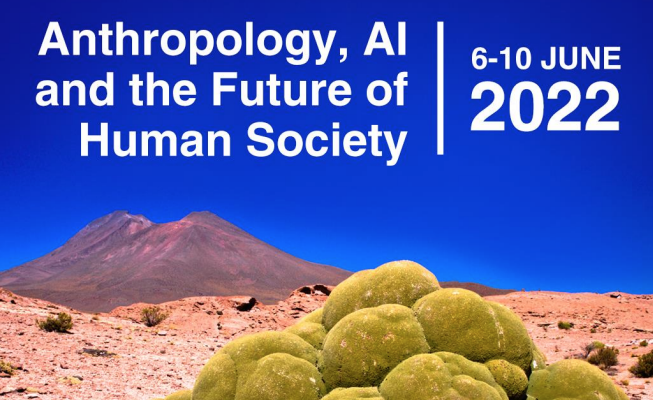The Making Culture Lab and CriticalMediartStudio (cMAS) was excited to present new work at the Royal Anthropological Institute Conference Anthropology, AI and the Future of Human Society.
Critical Research-Creation Engagements with Artificial Intelligence: New Works from the Making Culture Lab (MCL) and CriticalMediaArtStudio (cMAS), June 8, 6:30 am PST/ 2:30 pm UK
Our session “Critical Research-Creation Engagements with Artificial Intelligence: New Works from the Making Culture Lab and CriticalMediaArtStudio” includes presentations by Dr. Gabriela Aceves Sepulveda, Dr. Kate Hennessy, Steve DiPaola, Trudi Lynn Smith, Tylar Campbell, Dr. Cecil Brown, Brett Gaylor, Freya Zinovieff and Dr. prOphecy Sun. We pre-recorded our individual presentations, embedded below. The full conference roundtable recording and discussion with Dr. Cecil Brown and Dr. Steve DiPaola is available only via the RAI Conference website.
therai.org.uk/conferences/anthropology-ai-and-the-future-of-human-society
Full Abstract:
Chaired by: Kate Hennessy and Gabriela Aceves-Sepulveda
Discussant: Steve DiPaola
Convenors: Trudi Lynn Smith, Freya Zinovieff, prOphecy sun, Tylar Campbell, Cecil Brown, Brett Gaylor
Critical Research-Creation Engagements with Artificial Intelligence: New Works from the Making Culture Lab and CriticalMediaArtsStudio (cMAS)
In this roundtable, members of the Making Culture Lab and the CriticalMediaArtsStudio (cMAS) at Simon Fraser University, with collaborator and discussant Steve DiPaola, will present recent works engaging AI that represent, visualize, and critically interrogate expressions of gender, race, histories, relationalities, materiality, and cultural forms for exhibition and dialogue across disciplinary boundaries. As a method increasingly visible in anthropological work, research-creation brings together artistic and scholarly methodologies and legitimates hybrid outputs (Loveless 2015). It raises questions about the reshaping of artistic research into an academic discipline (Steryl 2010), and asks what is at stake in pedagogy, practice, and experimentation (Manning 2016).
Responding to the growing prominence of the multimodal in anthropology, we present research-creation artworks that act on calls for “an anthropology of the multimodal” (Takaragawa et. al. 2018; Smith and Hennessy 2020) that engages the multimodal’s position as an expression of technoscientific praxis and infrastructures, including artificial intelligence. This work shows how the multimodal, which is deeply intertwined with increasingly ubiquitous AI, is complicit in the reproduction of power hierarchies and forms of oppression but may also forge fugitive pathways to new ways of seeing and sensing. Works include engagements with oral history, race and fugitive spaces; machine vision and classification of the material; facial recognition and surveillance; AI-generated narrative, sonic decay, and poetry; and gendered bodies, kinship, and bacteria. The works point to possibilities for anthropology to critically engage with technoscience in critical practice and the place of research-creation as a method for an anthropology of the multimodal.
Loveless, Natalie S. 2015. “Towards a Manifesto on Research-Creation.” RACAR: Revue d’art canadienne / Canadian Art Review 40(1): 52–54.
Manning, Erin. 2016. “Ten Propositions for Research-Creation.” Collaboration in Performance Practice 19(2). Video, 25 min. Accessed May 23, 2020. doi.org/10.3998/3336451.0019.206.
Steryl, Hito. 2010. “Aesthetic of Resistance?” Journal of Artistic Research. 8: 21–37
Smith, Trudi Lynn, and Hennessy, Kate. .2020. Anarchival Materiality in Film Archives: Toward an Anthropology of the Multimodal. Visual Anthropology Review 36(1):113-136.
Takaragawa, Stephanie, Trudi Lynn Smith, Kate Hennessy, Patricia Alvarez Astacio, Jenny Chio, Coleman Nye, and Shalini Shankar. 2019. “Bad Habitus: Anthropology in the Age of the Multimodal.” American Anthropologist 121(2): 517–24.

